ANTHROPOGENICS
1/33
There's no tags or description
Looks like no tags are added yet.
Name | Mastery | Learn | Test | Matching | Spaced |
|---|
No study sessions yet.
34 Terms
What are threats to tropical ecosytems?
Tourism
Poison fishing
Overexploitation
Sedimentation
Coral harvesting
Dynamite fishing
Pollution
Climate change
What is the greenhouse effect?
Some sunlight that hits the Earth is reflected and some becomes heat
CO2 and other gases in the atmosphere trap heat, keeping the Earth warm
The greenhouse effect is how heat is retained by the atmosphere due to greenhouse gases and then radiated in all directions, warming the Earth
Occurs naturally
Magnified due to increased greenhouse gases
What is global warming?
The increase in average annual temperatures across the globe
Where is warming occurring the fastest?
The Arctic experiences the loss of reflective ice and snow, amplifying the rate of warmingand leading to significant ecological changes.
What are marine heatwaves?
When seawater temperatures exceed a seasonally-varying threshold (90th percentile) for at least 5 consecutive days
Occurring more frequent, more intense, and with longer duration
What causes marine heatwaves?
Ocean currents
Air-sea heat flux
Warming from atmosphere
WindW
What is ocean acidifcation?
Oceans have absorbed approximately 1/3 of CO2 produced by human activities
Decreased in pH due to the absorption of atmospheric CO2 that acidifies the surface layers of the ocean
What are the impacts of ocean acidification?
Decrease in pH
Increase in H+ (hydrogen ions)
Decrease in CO32- (carbonate ions)
What are the steps of ocean acidification?
CO2 dissolves in water
Reacts with H2O —> unstable H2CO3 (carbonic acid)
Increase in H+ and HCO3- (bicarbonate)
Decreased available CO32- (carbonate)
Decreased CaCO3 (calcium carbonate)
Increased HCO3- (bicarbonate)
What is global sea level rise?
Thermal expansion of the oceans as well as increased meltwater and discharged ice from terrestrial glaciers and ice sheets and increased ocean volume
Warmer oceans also drive more intense storm systems
What are the impacts of sea level rise?
‘Coastal squeeze’ of mangroves (expected 10-20% loss)
Communities at risk (New Orleans)
How does eutrophication affect coastal waters?
Hypoxia (inadequate oxygen) increased
What are the effects of climate change on ecosystem functions?
Temperature: fundamental effect on biological processes, enzyme reactions, diffusion, membrane transport
Animal metabolism is temperature dependent
Reduced fitness, population decline, local extinction
Reduced habitat complexity: impacts on habitat-forming species (corals, sea grass, mangroves, salt marsh grasses, and oysters)
Ecologically novel assemblages, exotic species, and disease
Development of novel assemblages of organisms with no past or contemporary counterparts
Rising number of exotic species
Higher changes that species being transported from lower latitudes are able to establish and spread
Local-global interactions, synergies, and threshholds
Coral bleaching + reduced calcification + sediments + nutrients + pollutants = reduced ability to recover
What are the types of responses to stressors?
Additive : A and B —> A + B
Antagonistic: A and B —> < (A + B)
Synergistic: A and B —> > (A + B)
What are the biological responses to global change?
Geographic range shifts
Acclimatization
Adaptation
Extinction
Adaptation vs acclimatization
Adaption: evolutionary process whereby a population moves towards the optimum for a particular environment over multiple generations
Genetic diversity is a way to adapt
More variation —> different alleles are better suited
Acclimatization: physiological modifications occurring within the lifetime of an individual organism that results from chronic exposure to a naturally occurring environmental challenge
Why is genetic variation important?
Genetic variation is the raw material for evolution
Buffer the demographic effects of environmental change
More likely resistant individuals that will persist over generations and allow the population to increase fitness
What is the performance curve?
Illustrate organism’s performance across a range of conditions
Tolerance varies among species
Pejus range: when physiological performance ceases to be optimal
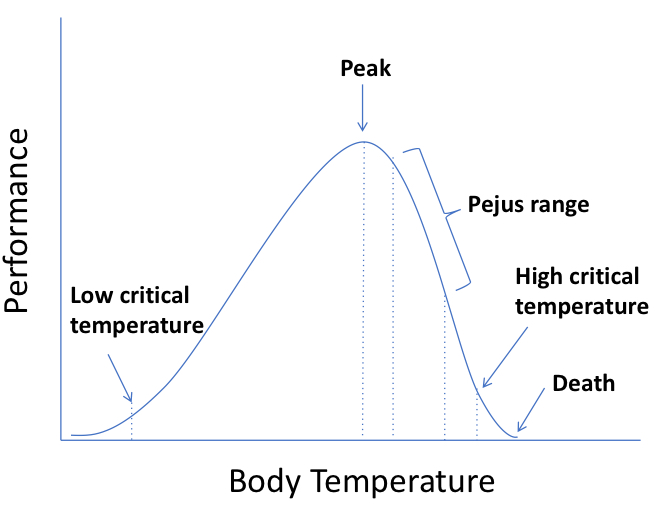
What are the implications of global warming on species’ performance curves?
Organisms living below performance optima will be moved closer to that optima (A)
Organisms living at their thermal optima may be moved beyond it, and experience declines in performance (B)

How will global warming affect specialist vs generalists?
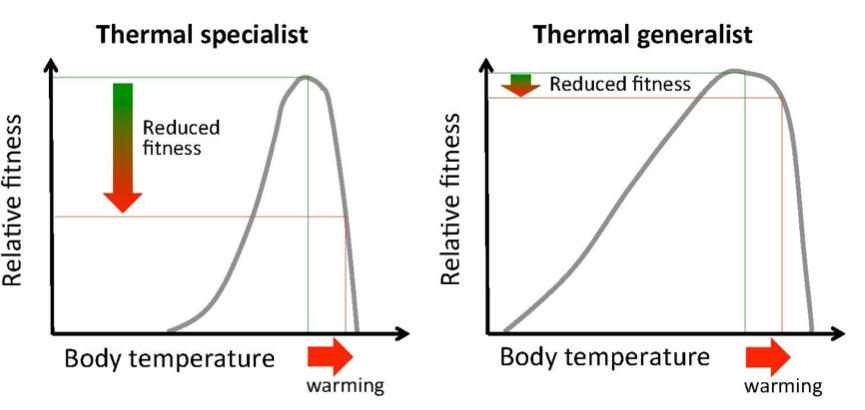
How can acclimatization help organisms?
Allows organisms to adjust the performance curve depending on environmental conditions
Involves phenotypically plastic responses (physiology, morphology, or behavior)
Acclimatization (field) does not equal acclimation (lab)
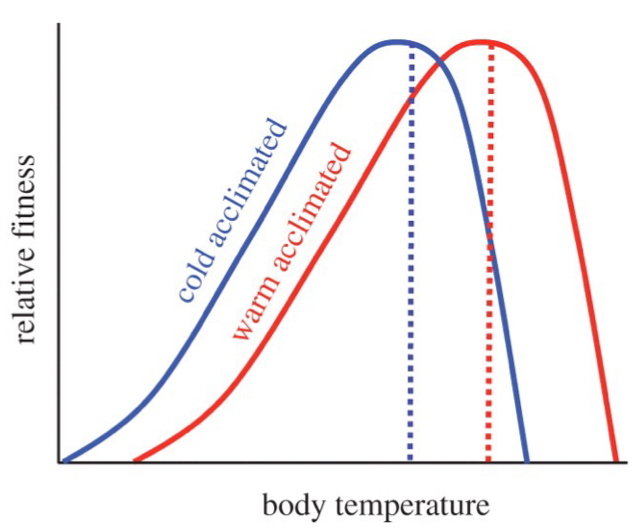
What are the types of acclimatization?
Reversible: days to months, often within a life stage
Developmental: when exposed to novel environment early in life enhances performance in that environment later in life
Transgenerational: environment experienced by the parents influences the performance of offspring
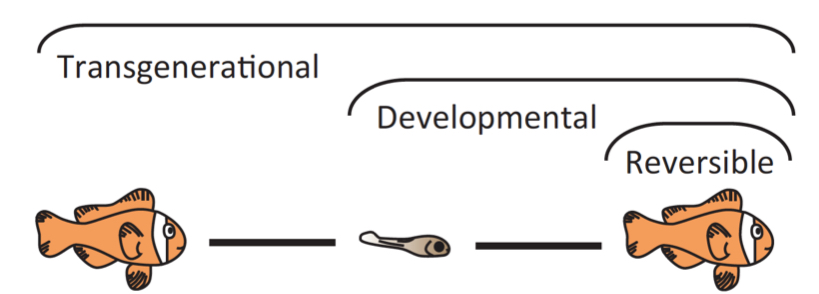
Resistance vs resilience
Resistance: property of communities to remain essentially unchanged when subject to disturbance
Resilience: capacity of ecosystems to absorb disturbances and respond to change while retaining the same function, structure and feedback

What are alternative stable states?
System with multiple equilibrium points (middle is the threshold)
Ecological threshold: a relatively rapid change from one ecological condition to another (unstable condition)
Exists at all levels of organization
Phase shifts: alternate state dominated by a different suite of organisms
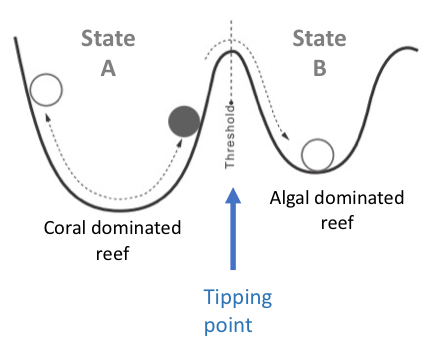
What are examples of global impacts?
Ocean acidification
Global warming (coral bleaching)
Sea level rise
What are examples of local impacts?
River runoff (sediments/nutrients)
Fishing/trawling (reef ecology)
Coral predators (crown of thorns)
How do ecosystems transition between states?
Healthy resilient coral-dominated reefs become progressively more vulnerable owing to fishing pressure, pollution, disease and coral bleaching
The dotted lines illustrate the loss of resilience that becomes evident when reefs fail to recover from disturbance and slide into less desirable states
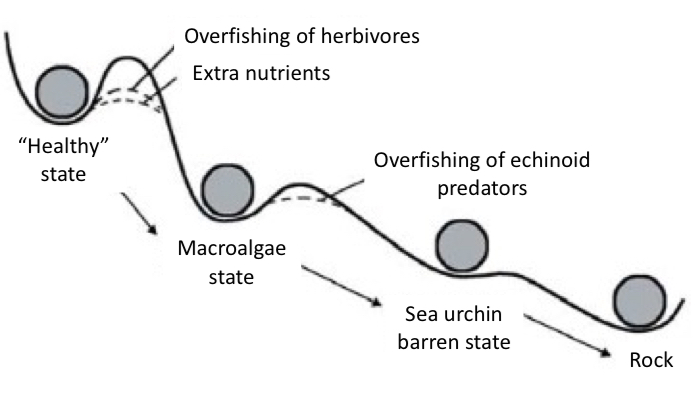
What is ecological resilience?
The size of the perturbation needed to push the system out of its current state
What are examples of slow drivers?
CHRON
Simultaneous and highly interactive
E.g., fishing, nutrients, and temperature
What are examples of fast drivers?
Episodic disturbances
Shocks that quickly push the system away from equilibrium
E.g., cyclones, storms
What is feedback?
The modification or control of a process or system by its results or effects
Stability depends on feedback that reinforce and maintain ecosystem states
Feedback plays a critical role in stabilizing or destabilizing coral-dominated and degraded states
Alternate states of the system become stable because they are reinforced by self-perpetuating positive or negative feedback mechanisms
May lead to bottleneck that reinforces the feedback
What are the types of feedback?
Negative feedback: activation of one component results in the inactivation of another
Positive feedback: activation of one component (e.g., grazing intensity) leads to the activation of another
Phase shifts vs alternative stable states
Phase shifts can be smooth or nonlinear
Alternative stable states show discontinuous change with some level of hyteresis

What is hysteresis?
The existence of different stable states under the same variables of parameters
When the pathway of recovery of an ecosystem differs from its pathway of degradation
Reversal of the stressor does not allow the system to back track along the same slope
Greater removal of the stressor must take place